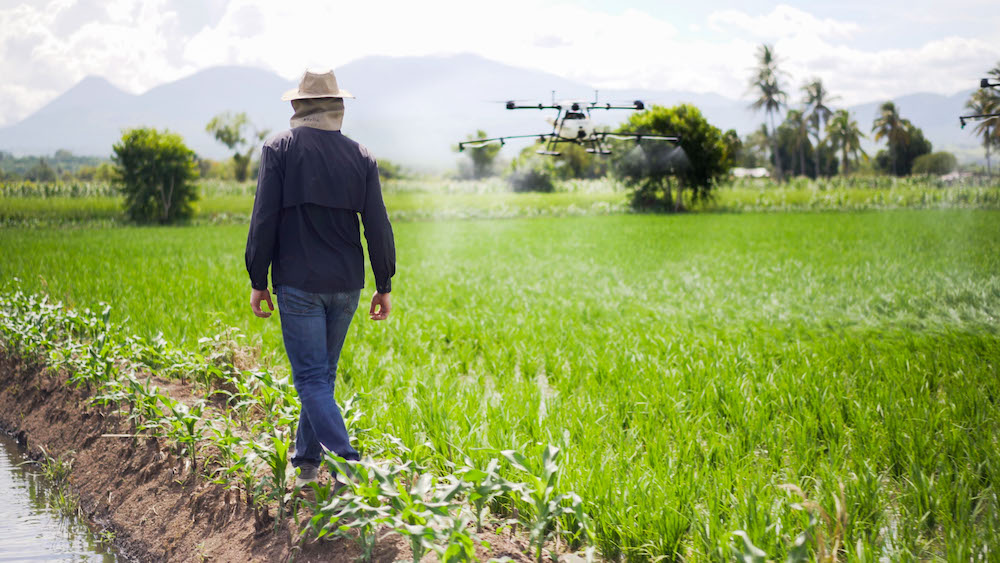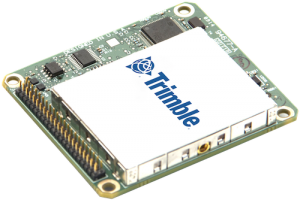
[ad_1]
Applanix and Hylio Enhance Agriculture

A Hylio AgroDrone treats a field of rice while a Hylio operator observes.
The amount of land and labor used on American farms has declined since the 1940s. Yet during the same period, agricultural output has nearly tripled, federal statistics show, because of one key factor: technology.
A main technological driver now boosting production in American agriculture is drones, which have enabled farms to increase crop yields while lowering pesticide use. The future of the agricultural industry, which recently celebrated National Farmers Day, lies in automating operations and adopting precision farming techniques, experts say.
Studies show that drones used in farming operations reduce costs. The average U.S. farmer using agricultural drones sees a return on investment of $12 per acre for corn, and $2 to $3 per acre for soybeans and wheat, according to research by the American Farm Bureau Federation.
“More farms are using drone technology and they are using better drone technology today than five years ago,” said Mohamed Mostafa, lead technical authority for mobile mapping for Applanix Corp., or Markham, Canada, which produces positioning and orientation systems for drones. “We have drones that fly longer times and have better cameras so you can see finer resolution on the ground.” Applanix is owned by software, hardware and services technology company Trimble.
Even small family-owned farms, which account for 90% of all U.S. farms, are integrating drones into their operations by contracting with service providers to deploy UAS for aerial mapping and crop spraying of fertilizer and pesticides.
With the average age of farmers in the United States rising to 57.5 years, drones are also helping to alleviate labor shortages and improving efficiency, said Louis Wasson, a senior extension associate at Mississippi State University and a drone instructor for USDA’s Wildlife Services.
“Drones save farmers a lot of time in not having to go out and spend time walking and looking at things,” Wasson said. “They can send the drone up and look at that precision spot. And you’re not spraying as much.”
Beyond Tractors and Crop Dusters
While farms have traditionally used tractors or crop dusters to spray crops with fertilizer and pesticides, that function is gradually being taken over by drones. Unmanned systems allow farmers to accurately pinpoint specific areas that need nutrients or protection from insects.
Tractors or crop dusters use a blanket approach to apply pesticides on entire fields, when only a portion of the crop may need applications of chemicals to control weeds, said Arthur Erickson, CEO and cofounder of Hylio, a Richmond, Texas-based company that produces agricultural drones.
“What tractors can’t do is spot treatment,” Erickson said. “Once the crop has started growing and it’s showing signs of fungus outbreak or some sort of weed outbreak in different sections of the field, you can’t go out there and isolate those spots and just spray that. You have to come in and spray everything—a shot-gun approach.”
This indiscriminate approach not only causes farmers to overspray pesticides, but it also carries health and environmental risks because of pesticide drift, the movement of pesticide dust or droplets through the air.
“Pesticides can flow into creeks and affect other living organizations,” Wasson said. “With spot spraying, you’re just spraying that individual location or area. You have more control where that chemical goes.”
Hylio’s AgroDrones reduce environmental spillover of pesticides because they allow farmers to target specific crop areas that need treatment. Each of the company’s three drones comes with high-definition video streaming, radar sensors that allow them to detect and avoid obstacles, and GPS modules capable of normal and RTK positioning.
- The AG-110 has a 2.6-gallon tank and can cover a 15- to 25-foot swath width at 15 acres/hour
- The AG-116 has a 4.2-gallon tank, and can cover a 25- to 30-foot swath width at 25-30 acres/hour
- And the AG-122 has two 2.6-gallon tanks, a 25- to 30-foot swath width and covers 30 to 35 acres/hour.
The cost of the drones ranges from $20,000 for the AG-110 to $40,000 for the AG-122. While smaller farms may contract with a drone-spraying service to apply pesticides, larger operations might purchase a fleet of three or four drones.
“All of our drones can be used in fleet formation, but mostly people who utilize fleets are going for maximum coverage,” Erickson said.
Creating Precise Imagery
Before spraying crops, farmers need high-resolution images so they can hone in on sections of their crops that need attention. While farms have used satellite imagery since the 1970s, drones carrying cameras and sensors can provide more precise data about crops.

The APX-15 is commonly used as one of the board sets provided by Applanix for georeferencing UAV-collected survey data.
Satellites produce images using pixels that cover two feet at the smallest level, but drones can zoom down to a square inch and allow farmers to see individual plants, including an assessment of its health, maturity and irrigation needs, according to Mostafa of Applanix.
The positioning and orientation systems Applanix produce are sold to service providers that install them on drones and provide survey images to farmers. These images allow farmers to improve yields, determine when crops need watering and advise when crops should be harvested. “That information is not available with satellite images,” Mostafa said.
Applanix’s product, the APX, is a miniaturized version of the company’s original system, developed in 1990. The latest models, which are smaller, lighter and consume less power, are sold to service providers that offer imaging surveys for both small and large farms.
In the near future, Mostafa expects drones to link the growing process, sales, transportation and any logistics that need location-based information. “Supporting the planting, cultivation and harvesting operations of pretty much all crop categories—perishable or unperishable—the drones will take over in the sense of monitoring the health, growth, disease fighting and even the watering of all crops.”
[ad_2]
Source link